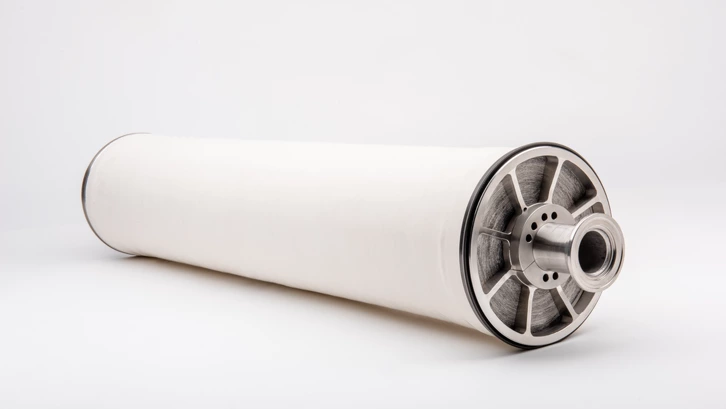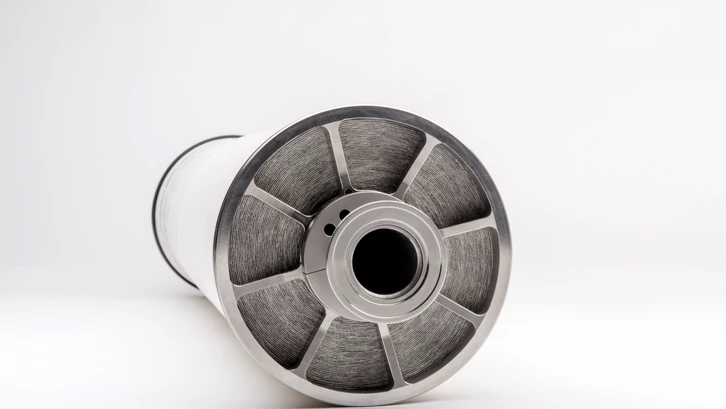
SEPURAN® NG & PURAMEM® H2S
membranes for efficient natural gas processing
Explore the forefront of gas purification technology with Evonik. Our SEPURAN® NG membrane delivers robust performance in high CO2 natural gas processing, while the innovative PURAMEM® H2S membrane efficiently removes H2S. Together, they ensure your natural gas meets quality standards with reliability and precision.
Download
Use in natural gas sources with high CO2 concentration
SEPURAN® NG is an especially robust, hollow fibre membrane, which is based on a high-performance plastic that can withstand extreme pressure and temperatures. This enables particularly selective separation of the sour gases from the natural gas, high tolerance of the higher hydrocarbons contained in the natural gas, and consistently high performance of the membrane throughout its lifetime.
The membrane is designed for the challenging process conditions of natural gas processing with complex gas compositions and typical pressure and temperature conditions up to 70°C. It can be used particularly effectively in natural gas sources with a high concentration of carbon dioxide because, under these conditions, the separating properties of the membrane remain intact.
The modular structure of SEPURAN® NG has been designed for conventional, membrane-based natural gas processing plants so that, during the membrane exchange, no further adaptations are required to the existing equipment.
How does natural gas processing with Evonik's SEPURAN® NG membrane work?

MEMBRANE FEATURES
- Consistently high performance - SEPURAN® NG is an especially robust, hollow-fibre membrane, which is based on a high-performance polymer that can withstand extreme pressure and temperatures, and features a stable performance even in the presence of H2S, water or higher hydrocarbon concentrations.
- Modular structure - Our membranes have been designed for conventional, membrane-based natural gas processing plants. As plug-in replacement for all standard 8” membranes no further adaptations are required to the existing equipment.
Boosting the performance of natural gas processing membrane plants
Although natural gas is considered a relative clean energy source, it comes from the ground in a mixture that often contains high concentration of CO2, which has some negative properties: it does not burn, and it reacts with water to form carbonic acid. Pipelines, gas turbines, heating systems, power plants, and engines would probably fail quite fast if they were operated with crude natural gas. Therefore, the availability of simple process technology to remove CO2 that can be applied in remote, unattended or offshore locations is highly desirable. Ease of operation, quick start-up, and high process availability are very important factors in addition to competitive capital and operating costs for the technology.
The dominant technology for CO2 removal is chemical absorption by Amines, which is widely used in the industry. Nevertheless, the natural gas processing market has a strong desire to look for process alternatives, since the amine technology has some drawbacks including ongoing chemical replacement, reliability of mechanical equipment, higher operating costs and environmental impacts (e.g. hydrocarbon emissions). Membrane systems overcome part of these drawbacks. They combine the advantages of lower operating costs, simple steady-state operational reliability, simplified turndown and expansion capabilities. Consequently, membranes were introduced to the market for natural gas processing applications in the mid 1980s. However, up to now membrane systems which are mainly based on cellulose acetate still have a minor market share. The factors used to limit the application of membranes include hydrocarbon losses, reliability of the membrane modules, lack of operational experience, a smaller reference list of membrane vendors and more stringent pretreatment requirements.
PURAMEM® H2S: Treating natural gas under challenging conditions


40 percent of world gas reserves are sourgas sources and contain not only CO2, but also H2S which needs to be removed to a very low level before further processing is possible and revenue can be obtained. Membrane technology with high-performance specialty polymers can offer a relatively simple and robust processing option compared to amine systems and are superior versus first generation polymeric membrane materials.
New H2S Treating Membrane
Evonik’s new PURAMEM® H2S membrane is applied in simple one- or two-stage configurations to provide bulk or deep removal of H2S depending on the required specification of the sales gas. The flat sheet PURAMEM® H2S complements our membrane portfolio for natural gas applications and are utilized together with SEPURAN® NG to treat challenging gas streams and meet stringent specifications for CO2 and H2S.
- Specialty polymer to provide a high H2S/CH4 selectivity for the efficient treatment of sour gases
- Highly robust and constant membrane performance in the presence of NGL-rich conditions
- PURAMEM® module design harmonized with SEPURAN® to allow highest flexibility for combination of both technologies to achieve treating goals of more complex gas feeds in one process step
- New installations or plug-and-play replacement of existing 8“ modules to increase the separation performance
- Spiral wound 8040 modules, stainless steel (1.4404 / 316L & 1.4571)
- Modules can be used in 8” and 8.25” pressure housings
- Max. operating pressure = 80 bar
- Max. operating temperature: 80°C
- Deep removal of H2S for pipeline gas applications
- Fuel gas conditioning to valorize waste gases / flare gases
- Bulk removal of super-sour natural gas streams as part of a Hybrid System
- Debottlenecking of existing amine units and sulfur removal technologies




